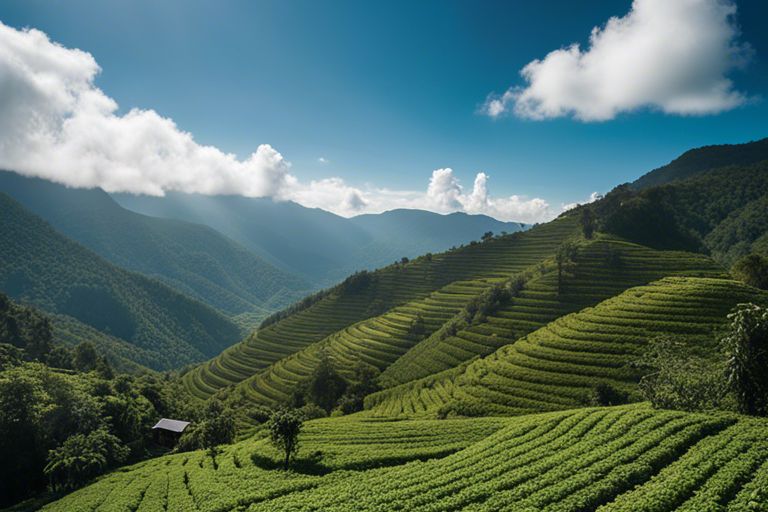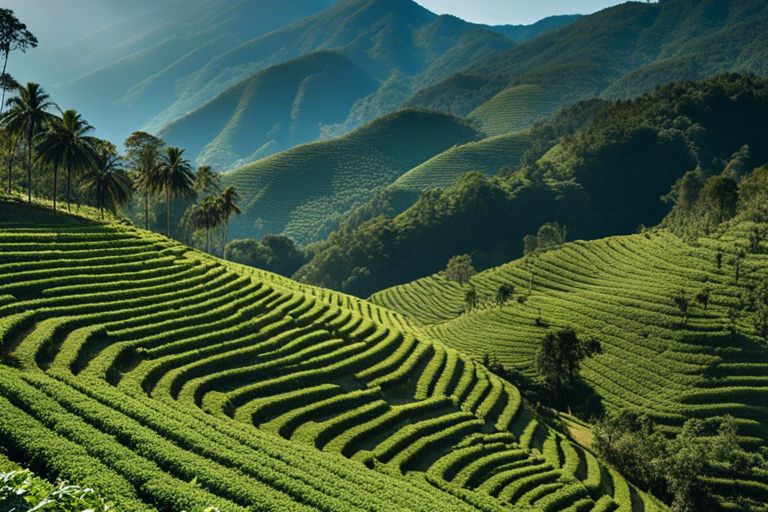It’s fascinating to explore the impact of elevation on the growth and flavor profile of coffee beans. From the cultivation to the final brew, altitude plays a significant role in shaping the characteristics of your daily cup of joe. To dive deeper into this topic, check out What Does Altitude Have to do with my Coffee? for a comprehensive understanding of this necessary aspect of coffee production.

Key Takeaways:
- Altitude plays a crucial role: Altitude affects the flavor profile and quality of coffee beans, with higher altitudes generally producing better coffee.
- Climate impact: Higher altitudes provide cooler temperatures, which slow down the maturation process of coffee beans, resulting in more complex flavors.
- Altitude and acidity: Coffee grown at higher altitudes tends to have higher acidity levels, which contribute to a brighter and more vibrant taste.
- Altitude and body: Beans grown at higher altitudes typically have a lighter body, allowing the flavors to shine through without being overpowered.
- Sustainable farming: Supporting coffee grown at higher altitudes encourages sustainable farming practices as it often involves less need for pesticides and artificial inputs.
The Ideal Climate for Coffee
Temperature Ranges
Climate
| Optimal Temperature: | 18-22 degrees Celsius |
| Impact of Temperature: | Consistent temperatures help in the gradual ripening of coffee cherries, leading to better flavor development. |
Humidity and Precipitation
The
Pertaining to humidity and precipitation, coffee plants thrive in regions with consistent rainfall and humidity levels. Coffee plants require a significant amount of water to grow and produce high-quality beans.
Humidity
High humidity levels are crucial for coffee plants, as they help in the pollination process and the development of healthy cherries. However, excessive humidity can lead to issues like mold and fungal diseases, so a balance is necessary for optimal coffee growth.

Altitude’s Impact on Coffee Flavor
Increased Acidity
Some coffee enthusiasts believe that altitude has a significant impact on the acidity levels in coffee beans. Altitudes higher than 3,000 feet above sea level are said to produce beans with a brighter and more pronounced acidity. This acidity adds a unique and vibrant flavor to the coffee, often described as citrusy or fruity.
Enhanced Flavor Profiles
For coffee plants grown at higher altitudes, the slower growth rate results in a denser bean. This slower maturation allows the beans to develop more complex sugars, resulting in a more flavorful cup of coffee. Additionally, the cooler temperatures at higher altitudes cause the coffee cherries to ripen more slowly, enhancing the depth and sweetness of the beans.
The combination of these factors leads to a richer and more nuanced flavor profile in high-altitude coffees, making them highly sought after by coffee connoisseurs looking for a distinctive tasting experience.
Body and Texture
The altitude at which coffee is grown can also influence its body and texture. Coffees grown at higher altitudes typically have a lighter body and a cleaner, more defined texture. This clarity in texture allows the flavors of the coffee to shine through, creating a more refined and enjoyable drinking experience.
Understanding how altitude affects the body and texture of coffee can help coffee drinkers choose beans that align with their flavor preferences and appreciate the nuances that altitude can bring to a cup of coffee.

Altitude’s Effect on Coffee Yield
Lower Yields at Higher Elevations
Many coffee enthusiasts are aware that altitude plays a crucial role in determining the quality of coffee beans. However, what may come as a surprise is that higher elevations often result in lower coffee yields. This is due to the challenges posed by colder temperatures and reduced oxygen levels, which can slow down the growth and development of coffee plants.
Thinner Air and Slower Growth
Coffee plants grown at higher altitudes face the challenge of thinner air, which can slow their growth rate. The reduced oxygen levels make it harder for the plants to carry out vital metabolic processes efficiently, leading to slower maturation and lower productivity.
Higher altitudes also mean cooler temperatures, which can further hinder the growth of coffee plants. The combination of thinner air and lower temperatures results in a longer maturation period for the coffee cherries, ultimately affecting the overall yield of the crop.
Increased Labor Costs
Another factor that influences coffee yield at higher altitudes is the increased labor costs associated with growing coffee in such challenging environments. The harsher conditions make it harder to cultivate and harvest the coffee crop, requiring more labor-intensive practices.
Labor Efficiency Challenges
Higher altitudes often mean steep and rugged terrain, making it more difficult for farmers to access the coffee plants and harvest the cherries. This not only increases the physical demands on farmers but also adds to the overall cost of production, impacting the final yield and profitability of the coffee crop.
Coffee Regions and Altitude
Once again, altitude plays a crucial role in determining the quality and flavor profile of coffee beans. Coffee is grown all around the world in different regions, each with its own unique altitude and climate conditions that contribute to the distinct characteristics of the beans.
The Andean Coffee Belt
Coffee grown in the Andean region, which includes countries like Colombia, Peru, and Ecuador, is renowned for its high altitudes. The elevations in these areas can range from 1,200 to 2,200 meters above sea level. The cooler temperatures and consistent rainfall at these heights create the perfect conditions for producing high-quality Arabica beans with complex flavors and bright acidity.
African High-Altitude Coffees
An important region for high-altitude coffee is East Africa, particularly countries like Ethiopia, Kenya, and Rwanda. Coffee plants thrive at elevations ranging from 1,400 to 2,200 meters above sea level in these regions. The beans produced here are known for their floral and fruity notes, and often exhibit a vibrant acidity and wine-like complexity.
Regions like Ethiopia, the birthplace of coffee, have a rich coffee culture and long history of coffee production. Ethiopian coffee, grown at high altitudes, is celebrated for its diverse range of flavors and exquisite quality.
Asian Coffee Regions
African countries aren’t the only ones producing high-altitude coffee; Asian regions like Indonesia and Vietnam also have coffee plantations at elevations of 1,200 meters and above. These areas are known for producing unique varieties like Sumatra Mandheling and Vietnamese Peaberry, each with its own distinct flavor profiles influenced by the altitude, climate, and soil of the region.
To truly appreciate the impact of altitude on coffee growth, one must explore the different coffee regions around the world and taste the diverse flavors that each altitude and climate can produce. From the high altitudes of the Andes to the African and Asian coffee-growing regions, altitude is a key factor in shaping the flavors and quality of the beloved beverage we all enjoy.
Farming Challenges at High Altitudes
Soil Erosion and Landslides
Keep in mind that farming at high altitudes comes with its own set of challenges. One major issue that coffee growers face is soil erosion and landslides. The steep slopes of mountainous regions where coffee is often grown are more susceptible to erosion, especially during heavy rains. This can lead to the loss of valuable topsoil and nutrients vital for coffee plant growth.
Frost and Freezing Temperatures
Keep in mind that frost and freezing temperatures can pose a significant risk to coffee crops at high altitudes. One of the main challenges for coffee farmers is protecting the delicate coffee plants from sudden drops in temperature, which can damage or kill the crops. Farmers often have to implement frost prevention techniques such as covering the plants or using heaters to ensure the survival of their coffee crop.
One
| Landslides | Limited Access to Resources |
Limited Access to Resources
Landslides can further exacerbate the challenges faced by coffee farmers at high altitudes by cutting off access to vital resources. When landslides occur, roads can be blocked, making it difficult for farmers to transport equipment, fertilizers, and other necessary supplies to their farms. This limited access can hinder the overall productivity and success of the coffee plantation.
To
Overcoming these farming challenges requires innovative solutions and careful planning to ensure the sustainability and resilience of coffee cultivation at high altitudes. By implementing erosion control measures, frost protection techniques, and developing strategies to mitigate the impact of landslides, coffee farmers can overcome these challenges and continue to produce high-quality beans in these unique growing conditions.

Benefits of High-Altitude Coffee
All coffee lovers can appreciate the unique qualities that high-altitude coffee brings to their cup. From increased antioxidants to unique flavor profiles, there are several reasons why high-altitude coffee stands out from the rest.
Increased Antioxidants
On high-altitude coffee farms, the plants are exposed to stronger sunlight, which triggers the production of antioxidants in the coffee cherries. Antioxidants are known for their health benefits, including reducing inflammation and protecting against diseases. This means that when you enjoy a cup of high-altitude coffee, you’re not just getting a flavorful pick-me-up, but also a dose of antioxidant goodness.
Unique Flavor Profiles
Benefits may not be limited to just health advantages, but also extend to the sensory experience. High-altitude coffee beans tend to mature more slowly due to the cooler temperatures and reduced oxygen levels, resulting in a denser bean with more concentrated flavors. These beans often exhibit a complex and vibrant flavor profile, with hints of fruitiness, floral notes, and a bright acidity that tantalizes the taste buds.
Understanding Sustainable Farming Practices
High-altitude coffee farming often goes hand in hand with sustainable practices that benefit both the environment and the coffee growers. Farmers in mountainous regions tend to rely on shade-grown methods, where coffee plants are cultivated under a canopy of diverse trees. This not only helps protect the coffee plants from extreme weather conditions but also promotes biodiversity and soil health on the farm.
High-altitude coffee farms also tend to be located in remote areas, encouraging a closer-knit relationship between farmers and their crops. This intimacy often translates into meticulous care for the coffee plants, resulting in high-quality beans that reflect the dedication of the farmers.
Another important aspect of sustainable farming practices in high-altitude coffee cultivation is water conservation. With the challenging terrain and limited water sources in mountainous regions, coffee farmers have developed innovative irrigation techniques that prioritize water efficiency and preservation. This commitment to sustainability not only ensures the longevity of coffee production at high altitudes but also contributes to the overall health of the ecosystem.
Summing up
Now, it is clear that altitude plays a crucial role in the growth and quality of coffee beans. Higher altitudes generally produce beans that are more flavorful and aromatic due to the slower growth and increased nutrient absorption. The cooler temperatures and higher elevations create ideal conditions for the beans to develop more complex flavors, making high-altitude coffee highly sought after by coffee enthusiasts.
FAQ
Q: What role does altitude play in coffee growth?
A: Altitude plays a crucial role in coffee growth as it affects the flavor profile and quality of the coffee beans. Higher altitudes, above 1,200 meters, provide cooler temperatures, more sunlight, and slower bean maturation, resulting in more complex flavors and higher acidity in the coffee.
Q: How does altitude impact the taste of coffee?
A: Coffee beans grown at higher altitudes tend to have a more vibrant acidity, a cleaner and sweeter taste, and a more complex flavor profile compared to beans grown at lower altitudes. Altitude influences the development of sugars and organic acids in the beans, creating a unique and desirable taste profile.
Q: What are the ideal altitude ranges for growing coffee?
A: The ideal altitude range for growing coffee is typically between 1,200 to 2,200 meters above sea level. In this range, the cooler temperatures and increased sunlight contribute to slower bean maturation, allowing for more complex flavors to develop. However, different coffee varieties may have specific altitude preferences, so it’s imperative to consider the specific needs of the coffee plant when choosing an altitude for cultivation.





